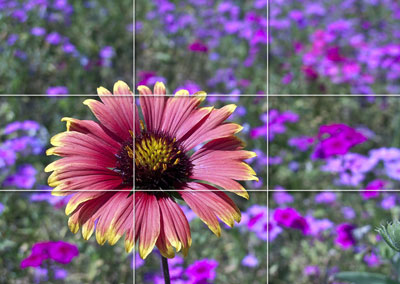Composition is the single most important decision you will make for most photographs. It is the one thing a “full auto” camera cannot do for you. Your choice of composition will often mean the difference between a nice snapshot and a truly great photo!
Roadside flowers pose a particular challenge because their growth patterns and visual context are highly variable and not under your control. So how do we impose some order on this chaos? One approach that goes back centuries is the Rule of Thirds. Rectangular photographs have natural points of visual emphasis that divide a composition into thirds. These four points or “aesthetic nodes” lie along lines at the 1/3-2/3 boundaries and divide the scene up into nine equal sections.

The basic idea is to locate your subject near one of these four nodes. Or if you have a boundary (like the horizon or a vertical wall), it should be placed along one of these lines.
There are also four diagonal lines of composition that evoke a “flow” from node to node (down and right, up and right, down and left, up and left). Here is a recent example.
This diagonal arrangement also helps bring a secondary subject into contrast with the primary as seen here.


